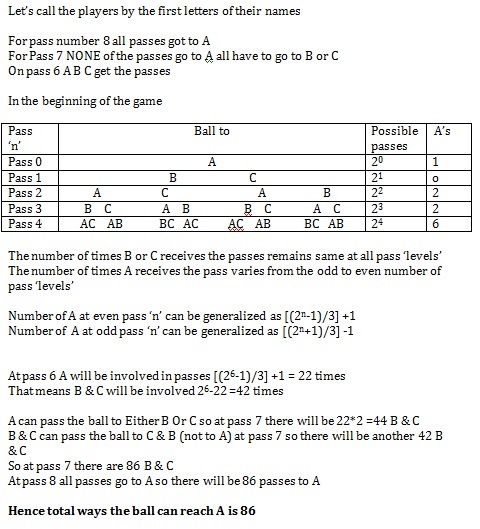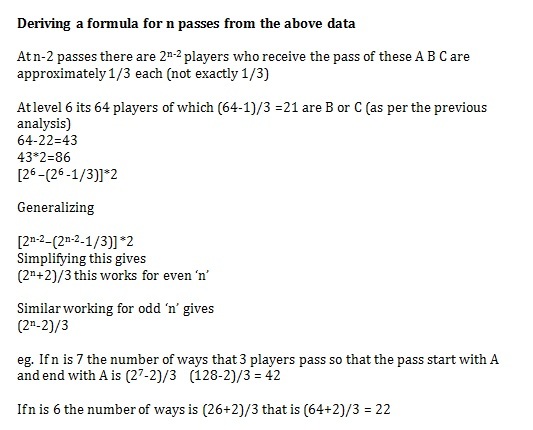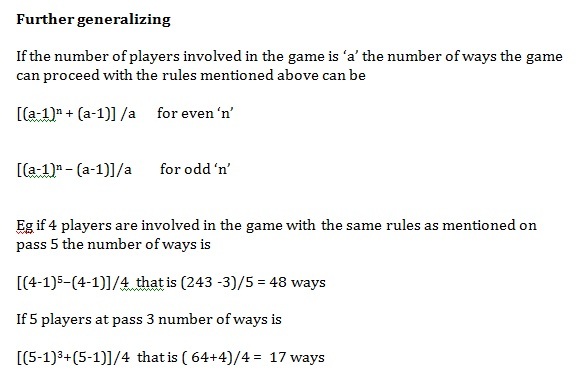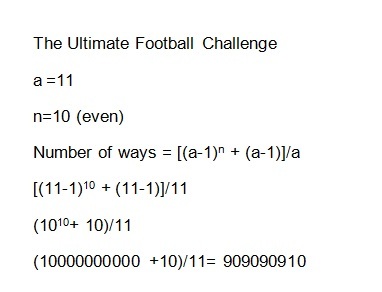The Ultimate Football Challenge
 Lionel Messi leads his team of 11 players onto the football field. The game begins. Messi starts the ball. The players of the team including Messi pass the ball amongst themselves till Messi receives the ball at the 10th pass and sends the ball soaring past the defenders into the net.
Lionel Messi leads his team of 11 players onto the football field. The game begins. Messi starts the ball. The players of the team including Messi pass the ball amongst themselves till Messi receives the ball at the 10th pass and sends the ball soaring past the defenders into the net.
How many ways could they have passed the ball, given that Messi starts the ball and receives it at the 10th pass?
Note : No one can pass the ball to themselves of course. A player can be passed the ball any number of times.
The answer is 909090910.
This section requires Javascript.
You are seeing this because something didn't load right. We suggest you, (a) try
refreshing the page, (b) enabling javascript if it is disabled on your browser and,
finally, (c)
loading the
non-javascript version of this page
. We're sorry about the hassle.
3 solutions
Very nice! Pawan..
Log in to reply
Thank you. Really enjoyed the problem... Seemed easy at first, tough at second look and finally it clicked!
This problem is similar to the "Ridiculous NBA" problem posted at this site Ridiculous NBA




Please excuse the images. I could not format it as per the requirements for posting here.
Sorry i am a little short on time right now to post a detailed approach, but after constructing and working on the problem, the following generalized formula emerges.
Let n be the number of passes.
Let p be the number of players.
If n is even, we have the number of ways ---
p ( p − 1 ) n + ( p − 1 )
If n is odd, we have the number of ways - - -
p ( p − 1 ) n − ( p − 1 )
hw did u derive this??
Log in to reply
Please refer to the detailed excellent solution by Harshad. Tx.
Since Messi receives the ball at 1 0 t h pass, therefore the ball is possessed by 1 1 players during the course of the goal.
Let the sequence of players to possess the ball be: { P 1 , P 2 , P 3 , P 4 , P 5 , P 6 , P 7 , P 8 , P 9 , P 1 0 , P 1 1 } .
In order to find the total ways to pass the ball, effectively we need to find permutations of 8 players { P 3 , P 4 , P 5 , P 6 , P 7 , P 8 , P 9 , P 1 0 } given that P 2 can have 1 0 choices and P 1 0 = Messi .
The sequence { P 3 , P 4 , P 5 , P 6 , P 7 , P 8 , P 9 } can have Messi n times, 0 ≤ n ≤ 4 .
There are ( 8 − n ) C n ways to place n Messi in sequence { P 3 , P 4 , P 5 , P 6 , P 7 , P 8 , P 9 } . ( ∗ Proof below).
In sequence { P 3 , P 4 , P 5 , P 6 , P 7 , P 8 , P 9 , P 1 0 } , there are n Messi , the subsequent place can have 1 0 choices and the remaining ( 8 − 2 n ) places can have 9 choices.
∴ Total Permutations of { P 3 , P 4 , P 5 , P 6 , P 7 , P 8 , P 9 , P 1 0 } for n occurrence of Messi = ( 8 − n ) C n × 1 0 m × 9 ( 8 − 2 n )
⇒ Total Permutations of { P 3 , P 4 , P 5 , P 6 , P 7 , P 8 , P 9 , P 1 0 } = ∑ n = 0 4 ( 8 − n ) C n × 1 0 m × 9 ( 8 − 2 n )
Since there are 1 0 choices for P 2 , therefore total permutations = 1 0 × ∑ n = 0 4 ( 8 − n ) C n × 1 0 m × 9 ( 8 − 2 n )
= 1 0 × ( 1 × 1 0 0 × 9 8 + 7 C 1 × 1 0 1 × 9 6 + 6 C 2 × 1 0 2 × 9 4 + 5 C 3 × 1 0 3 × 9 2 + 4 C 4 × 1 0 4 × 9 0 )
= 9 0 9 0 9 0 9 1 0
∗ There are ( 8 − n ) C n ways to place n Messi in sequence { P 3 , P 4 , P 5 , P 6 , P 7 , P 8 , P 9 } .
Proof:
There are ( 7 − n ) players to be placed between n occurrences of Messi .
_ X _ X _ … _ X _ X _
This is equivalent to placing n Messi in ( 7 − n + 1 ) empty slots and there are exactly ( 8 − n ) C n ways to do so...